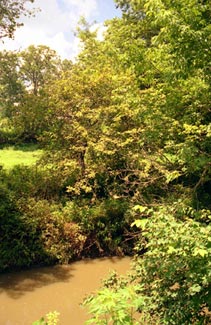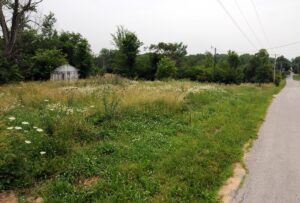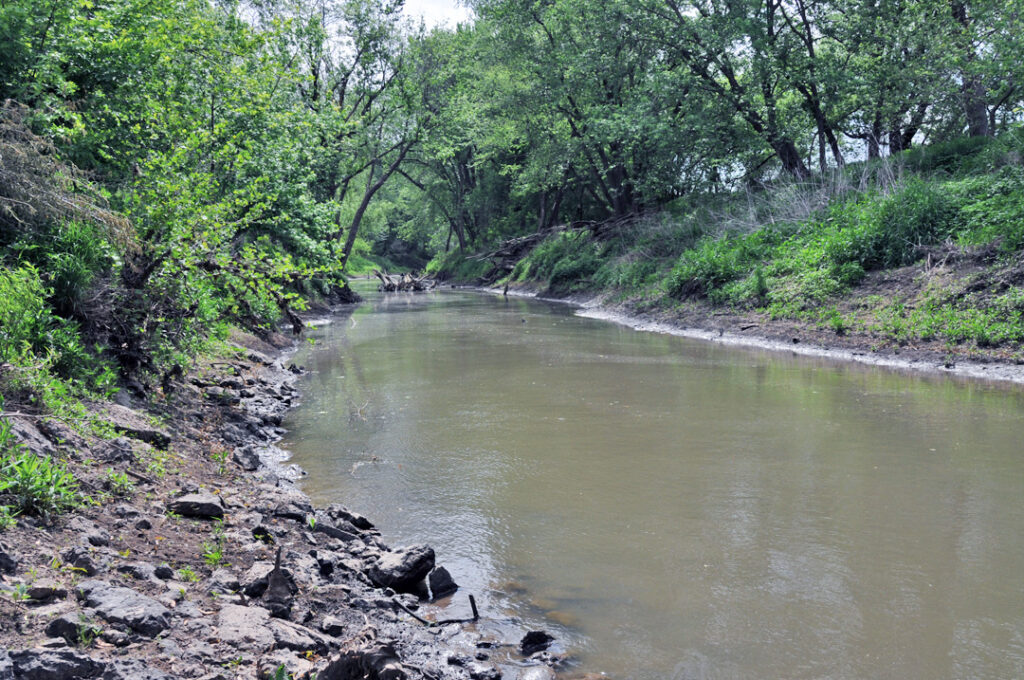Zion’s Camp at Fishing River, Clay County, Missouri, USA

Photo courtesy of Steve Mortensen
Zion’s Camp was organized on May 6, 1834 near New Portage, Ohio in response to Mormon persecution in Jackson County, Missouri. Earlier that year, on February 24, 1834, the Lord had commanded the Prophet Joseph Smith to organize a group to aid the “brethren, who have been scattered on the land of Zion.”1 Many of the Saints had been forced out of their homes and fled into Clay County to escape mob violence in late 1833. Zion’s Camp was formed to bring aid and relief to the suffering Saints and to reclaim their lands in Jackson County, Missouri which Church members viewed as the core of Zion.
The camp began with just over 100 men, but by the time they reached Missouri, additional men met up with them bringing their number to over 200. In total, the members of Zion’s Camp traveled 880 miles on foot between Kirtland and Missouri. They were organized into companies of tens and fifties with a captain at the head of each company.
The march of Zion’s Camp was a refining period for many early leaders of the Church. George A. Smith, future apostle and 16 year-old cousin of the Prophet Joseph Smith described that he was “so weary, hungry and sleepy that I dreamed while walking along the road of seeing a beautiful stream of water by a pleasant shade and a nice loaf of bread and a bottle of milk laid out on a cloth by the side of the spring.”2
Members of Zion’s Camp endured a limited food and water supply, unsanitary conditions, traveling through humidity, rain, and mud for sometimes as many as 40 miles a day.3 The difficulties lead to some members of Zion’s Camp becoming greatly discouraged and Joseph exhorted them “to humble themselves before the Lord and become united, that they might not be scourged.”4
On June 19, the group had reached Clay County and began to set up camp between the Little and Big Fishing Rivers. Five armed men rode into camp and told them that a group of Missourians were amassing with the intent of killing “Joe Smith and his army.” A tremendous storm soon arose in which rain, hail, thunder and lighting came down upon the mob and prevented them from attacking the members of the camp. Joseph and the others took refuge for the night in a small Church not far away.

When Colonel Sconce met Joseph Smith on June 21, he acknowledged “there is an Almighty power that protects this people, for I started from Richmond, Ray county, with a company of armed men, having a fixed determination to destroy you, but was kept back by the storm, and was not able to reach you.”5
However, due to the camp’s continuing murmurings against the Prophet and disobedience to the Lord’s commandments, cholera broke out among them and 13 members of Zion’s Camp died including Sidney A. Gilbert, part-owner of the Gilbert Whitney Store in Independence.
While at the farm of John Cooper near Fishing River, Joseph Smith received Doctrine & Covenants 105 stating that “it is expedient in me that mine elders should wait for a little season for the redemption of Zion.”6 Subsequently, Zion’s camp was officially disbanded on July 3, 1834. Nevertheless, the instruction and experience many of the early leaders of the Church received during Zion’s Camp became invaluable to further establish the Church. All save three members of the original Quorum of the Twelve Apostles and the original First Quorum of the Seventy participated in Zion’s Camp.

In speaking about his experience in Zion’s Camp, Brigham Young expressed that watching Joseph’s leadership during Zion’s Camp was “the starting point of my knowing how to lead Israel.”7 President Young would later lead the Saints out of Missouri to Illinois while Joseph was incarcerated in Liberty Jail and eventually out of Illinois to the Salt Lake Valley.
SOURCES
1 Doctrine & Covenants 103:1.
2 George A. Smith, “Writings of Early Latter-day Saints,” Juvenile Instructor, 78.
3 Alexander L. Baugh, “Joseph Smith and Zion’s Camp,” Ensign, (June 2005), 42.
4 Joseph Smith, History of The Church of Jesus Christ of Latter-day Saints, 7 vols., introduction and notes by B. H. Roberts (Salt Lake City: The Church of Jesus Christ of Latter-day Saints, 1932-1951), 2: 68.
5 Ibid, 2:105-106.
6 Doctrine & Covenants 105:9.
7 Quoted in Susan Evans McCloud, Brigham Young, A Personal Portrait (American Fork, Ut.: Covenant Communications, 1996).
Map & Directions
Address: The river can be seen from various sites in Clay County. It is suggested that one drive on Highway H about ten miles east of Liberty and 2.8 miles southwest of Excelsior Springs. According to Max H Parkin, that is close to where the Zion’s Camp members camped. (See Sacred Places, Vol. 4, 589.)
Ownership Status
There is not a single particular site or spot to go where one can see the river. It sometimes flows through private property, near public roads and the like. Consequently, the ownership will vary from site to site. The visitor is directed to the address immediately above.
Photos

Articles & Resources
Various Accounts of the Miracle near Fishing River
Author(s): Joseph Smith, Heber C. Kimball, Nathan Baldwin, Seymour B. Young, & Levi W. Hancock
Type: First and Third-person accounts
Source(s): Joseph Smith, History of The Church of Jesus Christ of Latter-day Saints, 7 vols., introduction and notes by B. H. Roberts (Salt Lake City: The Church of Jesus Christ of Latter-day Saints, 1932-1951), 2: 103-105; Orson F. Whitney, Life of Heber C. Kimball (Salt Lake City: Kimball Family, 1888), 53; Milton V. Backman, Jr. and Richard O. Cowan, Joseph Smith and the Doctrine and Covenants (Salt Lake City: Deseret Book Co., 1992), 99; Seymour B. Young., Conference Report, (April 1915), 125; Hyrum L. Andrus and Helen Mae Andrus, comps., They Knew the Prophet (Salt Lake City: Bookcraft, 1974), 22.
The greatest miracle in our favor was when we had got between the two branches of Fishing River, on a high ridge by…
Various Accounts of the Outbreak of Cholera in Zion's Camp
Author(s): Joseph Smith, Heber C. Kimball, Wilford Woodruff, & Seymour B. Young
Type: First and Third-person accounts
Source(s): Joseph Smith, History of The Church of Jesus Christ of Latter-day Saints, 7 vols., introduction and notes by B. H. Roberts (Salt Lake City: The Church of Jesus Christ of Latter-day Saints, 1932-1951), 2: 80, 106-107; Orson F. Whitney, Life of Heber C. Kimball (Salt Lake City: Kimball Family, 1888), 56; Brian H. Stuy, ed., Collected Discourses, 5 vols. (Burbank, Calif., and Woodland Hills, Ut.: B.H.S. Publishing, 1987-1992), Volume 2; President Seymour B. Young, Conference Report, (April 1915), 125-126.
While we were refreshing ourselves and teams about the middle of the day [June 3rd], I got up on a wagon wheel, called the people together, and said that I would deliver a prophecy. After giving the brethren much good advice, exhorting them to faithfulness and humility, I said the Lord had revealed to me that a scourge would come upon…
Zion’s Camp at Fishing River, at JosephSmith.net
Fishing River, at Doctrine & Covenants Revelation Sites Website
“Zion’s Camp,” in Encyclopedia of Mormonism, ed. Daniel H. Ludlow et al., 1992.
Milton V. Backman, Jr. comp., A Profile of Latter-day Saints of Kirtland, Ohio, and Members of Zion’s Camp, 1830-1839, 1982.
Alexander L. Baugh, “Joseph Smith and Zion’s Camp,” Ensign, June 2005, 42.
Ensign, June 2005, 42.
Daniel F. Boone, “Zion’s Camp: A Study in Obedience, Then and Now,” The Heavens are Open: The 1992 Sperry Symposium on the Doctrine & Covenants and Church History, ed. B. R. Merrill, 1993.
James Bradley, Zion’s Camp 1834: Prelude to the Civil War, 1990.
Donald Q. Cannon, “Zelph Revisited,” in Regional Studies in Latter-day Saint Church History: Illinois, ed. H. Dean Garrett, 1995.
Peter L. Crawley & Richard L. Anderson, “The Political and Social Realities of Zion’s Camp,” BYU Studies, 1974.
C. Fry, “Zion’s Camp; or the Expedition to Missouri. Its Purpose,” Journal of History, 1913.
Donald G. Godfrey, “The Zelph Story,” BYU Studies, 1989.
Andrew Jenson, “Zion’s Camp,” Historical Record, 1888.
Andrew Jenson, “Members of Zion’s Camp,” Historical Record, 1889.
Stanley B. Kimball, “Zion’s Camp March from Ohio to Missouri, 1834,” Ensign, April 1979, 45.
Ensign, April 1979, 45.
Warren A. Jennings, “The Army of Israel Marches into Missouri,” Missouri Historical Review, 1968.
Rodger D. Launius, “The Resuce of Zion’s Camp,” Restoration Witness, 1980.
Rodger D. Launius, Zion’s Camp: Expedition to Missouri, 1834, 1984.
Lyman O. Littlefield, “The Prophet Joseph Smith in Zion’s Camp,” Juvenille Instructor, 1892.
J. Parry, “The Story of Zion’s Camp,” Juvenille Instructor, 1902.
George A. Smith, “My Journal,” Instructor, 1946.
Bruce Van Orden, “Zion’s Camp: A Refiner’s Fire,” in The Prophet Joseph, eds. Larry C. Porter and Susan Easton Black, 1988.
Ronald W. Walker, “Zion’s Camp,” Tambuli, December 1978, 37.
Tambuli, December 1978, 37.
